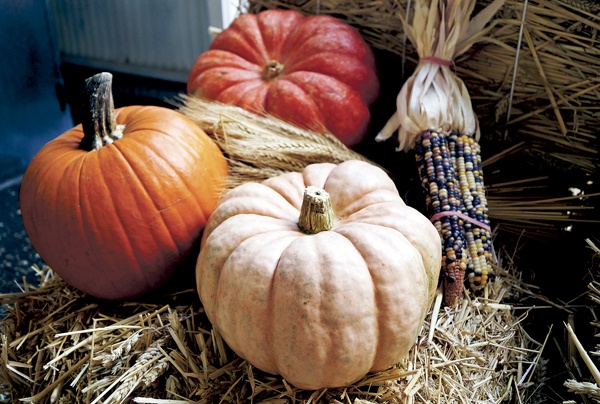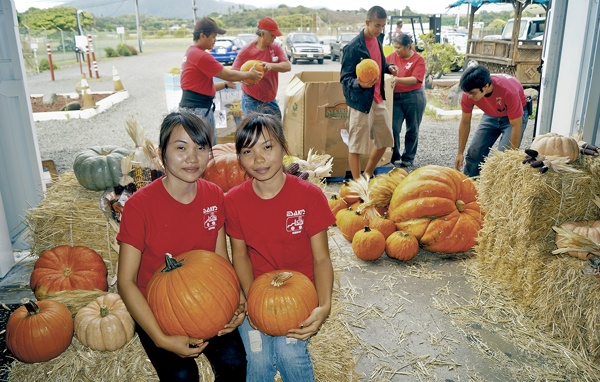KAPA‘A — Nui Yothachai and Peaw Meephol were beyond excited Tuesday, said Earl Kashiwagi of Esaki’s Produce, a fresh fruit and vegetable wholesaler in Kapa‘a. “The girls are from Thailand and work at Kai Farm in Kealia,” Kashiwagi said. “They
KAPA‘A — Nui Yothachai and Peaw Meephol were beyond excited Tuesday, said Earl Kashiwagi of Esaki’s Produce, a fresh fruit and vegetable wholesaler in Kapa‘a.
“The girls are from Thailand and work at Kai Farm in Kealia,” Kashiwagi said. “They just started working here and when they saw all the Halloween things. (They) just got so excited. They were taking pictures of each other with the different pumpkins, posing with all of the different items and just getting so excited.”
With just a smattering of English, the two girls from Thailand work with the staff of Esaki’s Produce to help fill orders from the various retail outlets and restaurant customers.
“Eventually, they’ll learn English and hopefully, they can work in the sales department to help our Thai customers,” Kashiwagi said. “That’s the long-term plan. Right now, they’re just excited because this is their first Halloween.”
The Halloween pumpkins and its assorted offerings of dried corn, straw bales and decorative squashes mark the start of the holiday season for the Kapa‘a wholesaler.
“People carry a lot of these things over into Thanksgiving, and then, it’s Christmas and New Year’s,” Kashiwagi said. “This is an exciting time of the year.”
Adding to the excitement, Kashiwagi said a local farmer, Harry Yamamoto, just delivered about 4,000 pounds of pumpkin his family grew in Kapa‘a.
“This is the first year we can offer locally-grown pumpkins for jack-o-lanterns and pumpkin carving,” Kashiwagi said. “People used to grow some a long time ago, but recently, we couldn’t get any until Harry approached us.”
Kashiwagi said originally, Yamamoto had about 10,000 pounds in the ground, but with the rains about three weeks ago, lost more than half his crop.
“He said it was a learning experience,” Kashiwagi said. “Next year, he said he learned he needs to harvest the pumpkins before the rains come. It also explains why the old-timers used to put the pumpkins on dried buffalo grass — it keeps them off the ground and helps keep them from being damaged.”
Yamamoto’s delivery of jack-o-lantern pumpkins helps with the Esaki’s ordering, in addition to being locally grown.
“We used to bring in a full container and mix extras into other produce,” Kashiwagi said. “This year, with Harry’s pumpkins, we just need to bring in the full container of Halloween and fall-related items. It helps ordering, a lot.”
Adding to the excitement, Kashiwagi said there are schools on Kaua‘i placing orders for pumpkins, which will be delivered in a few days.
“It’s good the schools are doing this,” he said. “I think they’re ordering en masse and distributing the pumpkins to their students. It’s something good because usually the kids don’t get into the holiday unless it’s candy.”
Pumpkins are the mainstay of the Halloween celebration, Kashiwagi pointing out the latest craze is a pink pumpkin, a spin-off of the Pink Pumpkin Patch Foundation, created in 2012, to aid in the fight against breast cancer, states the pink pumpkin website, which points out pink pumpkin promotions across the country with the foundation overseeing the donations and ensure the funds go to reputable organizations.
The biggest seller is the jack-o-lantern pumpkin, the variety delivered by Yamamoto, and most commonly found at the retail outlets.
“This is different from the pumpkin pie pumpkin in that it has a thinner wall for easier carving,” Kashiwagi said. “The pie pumpkin is blue, gray, or blue in color, but has a bright orange flesh, which makes the color in the pie. It also isn’t very big — just big enough to make one, or two pies — and is really popular with the older shoppers.”
Labeled the Jarrahdale Pumpkin, it is described by online sources as being six to 10 pounds in weight of superb quality with a flat and ribbed shape, being very decorative-looking and a good keeper.
The heavyweight is not really a pumpkin at all, Kashiwagi said. The giant pumpkins, some weighing between 130 and 150 pounds, are actually squashes called the Big Max.
“These can grow up to 1,000 pounds and across the country there are growers who have their own ‘secret’ ingredients, which cause the pumpkin to grow to massive sizes,” Kashiwagi said.
At a rate of about a dollar a pound, imagine, a $150 jack-o-lantern?
On the other extreme, the miniature pumpkins have a taste resembling sweet potato and are used as pumpkin soups and custards, Kashiwagi said, the insides being scrapped to make the soup or custard and the shell being used as a bowl to serve the dish.
Enhancing the pumpkins, the “accessory” items include ears of dried corn, including the Indian corn, which can be ground to make corn meal and a dried popcorn that, when placed in a microwave oven, pops into the familiar kernels, some of them still on the ear.
“We also bring in straw bales and decorative squashes, which are varnished and used as decorations,” Kashiwagi said. “This year, wheat was hard to come by, but we still have the straw bales, the difference being hay is grass while straw is made from wheat.”
He said if you get hay wet, it’s all over, but you can leave straw out in the rain and it won’t rot.
• Dennis Fujimoto, photographer and staff writer, can be reached at 245-3681 (ext. 253) or dfujimoto@ thegardenisland.com.



